Table of Contents
Welcome to Kizworld's comprehensive guide on How to do a pull-up. Whether you're a fitness newbie or a seasoned athlete, our in-depth guide will equip you with the knowledge and techniques to master this classic exercise. Join us as we explore the proper form, variations, training methods, and common mistakes to help you achieve pull-up perfection.
How to Do a Pull-Up: The Ultimate Guide to Mastering Pull-Ups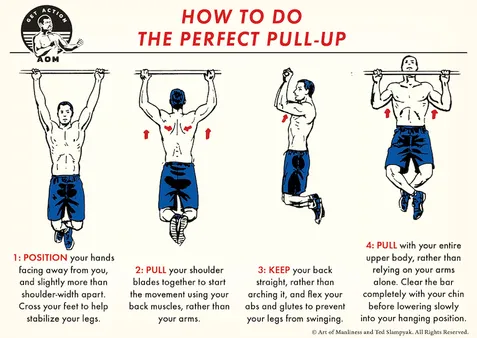
I. Master the Art of Pull-Ups: A Comprehensive Guide to Building Upper Body Strength
Master the Art of Pull-Ups: A Comprehensive Guide to Building Upper Body Strength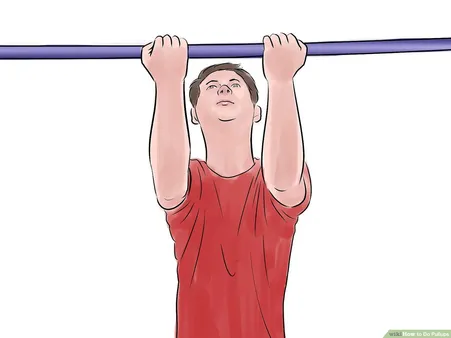
Embark on a journey to conquer the pull-up bar and unlock your fitness potential. This comprehensive guide, brought to you by kizworld, delves into the intricacies of mastering pull-ups, providing a step-by-step roadmap to success. Whether you're a beginner seeking to conquer your first pull-up or an experienced athlete looking to refine your technique, this guide equips you with the knowledge and tools to excel. Prepare to transform your physique, build strength, and achieve the perfect pull-up.
II. Proper Warm-up
A thorough warm-up prepares your muscles for the strenuous activity of pull-ups, reducing the risk of injury and optimizing performance.
- Begin with light cardio, such as brisk walking or jogging, to elevate your heart rate and promote blood flow to the muscles.
- Perform dynamic stretches targeting the muscles involved in pull-ups, such as shoulder circles, arm swings, and torso twists.
- Focus on static stretches, holding each position for 10-15 seconds, to enhance flexibility in the shoulders, back, and arms.
Explore Proper Warm-up Exercises for Pull-ups
III. Grip Variations
Experiment with different grip variations to engage various muscle groups and distribute the load more effectively.
- Pronated Grip: palms facing away from you, this grip activates the biceps and forearms.
- Supinated Grip: palms facing towards you, this grip emphasizes the lats and upper back.
- Neutral Grip: palms facing each other, this grip provides a balance of muscle activation and is often easier for beginners.
- Mixed Grip: one hand pronated and the other supinated, this grip offers a combination of benefits from both grips.
Discover Different Grip Variations for Pull-ups
IV. Form and Technique
Mastering proper form and technique is crucial for maximizing the benefits of pull-ups and preventing injury.
- Position yourself beneath the bar with hands slightly wider than shoulder-width apart.
- Engage your core and retract your shoulder blades to create a strong upper body position.
- Bend your knees slightly and jump up to grasp the bar with an overhand grip.
- Pull yourself up by contracting your back muscles, keeping your elbows close to your body.
- Lower yourself back down in a controlled manner, maintaining tension in your muscles.
Learn Proper Form and Technique for Pull-ups
V. Negative Pull-ups
Negative pull-ups, where you slowly lower yourself from a raised position, help develop the strength necessary for full pull-ups.
- Start by standing on a box or bench that allows you to reach the bar with your chin.
- Grasp the bar with an overhand grip slightly wider than shoulder-width apart.
- Engage your core and retract your shoulder blades to create a strong upper body position.
- Lower yourself down slowly and in a controlled manner, focusing on engaging your back muscles.
- Once you reach the bottom, step down from the box or bench and repeat the exercise.
Master Negative Pull-ups for Strength Development
VI. Progressing from Negative Pull-ups to Pull-ups
As you gain strength and proficiency in negative pull-ups, gradually transition to full pull-ups.
- Begin by performing assisted pull-ups using a resistance band or machine to reduce the amount of weight you need to lift.
- As you progress, decrease the assistance gradually until you are able to perform full pull-ups without assistance.
- Focus on maintaining proper form and technique throughout your progression.
Learn How to Progress from Negative Pull-ups to Pull-ups
VII. Perfecting Your Pull-Up Technique: Step-by-Step Instructions for Beginners
Perfecting Your Pull-Up Technique: Step-by-Step Instructions for Beginners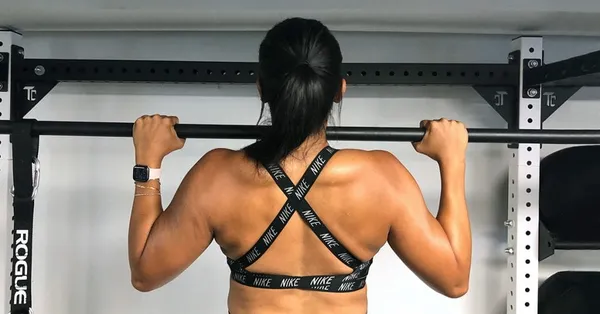
Mastering the Fundamentals
Achieving the perfect pull-up requires a combination of proper technique, strength, and practice. Beginners should start by focusing on the basics, ensuring they have the necessary foundation to progress safely and effectively.
The first step is to establish a strong grip. Position your hands slightly wider than shoulder-width apart, with your palms facing away from you. Your grip should be firm but not too tight, as this can restrict blood flow to the forearms.
Engaging the Right Muscles
When performing a pull-up, it's crucial to engage the correct muscles to avoid strain or injury. To initiate the movement, focus on pulling with your lats, the large muscles in your back. These muscles are responsible for bringing your body up towards the bar.
As you pull, squeeze your shoulder blades together to activate your upper back muscles, including your trapezius and rhomboids. Engage your core by tightening your abdominal muscles to stabilize your body and prevent swinging. Additionally, keep your legs extended and slightly crossed to maintain proper body alignment.
Controlled Descent
The descent phase of the pull-up is equally important. Avoid dropping down passively, as this can put excessive stress on your joints. Instead, control the movement by slowly lowering your body back to the starting position.
Focus on maintaining tension in your muscles throughout the entire rep to maximize muscle activation and minimize the risk of injury.
Remember, consistency is key when it comes to mastering the pull-up. Regular practice and attention to proper form will help you achieve your fitness goals and enjoy the numerous benefits of this classic bodyweight exercise.
VIII. Overcoming Common Pull-Up Challenges: Tips and Tricks for Success
Overcoming Common Pull-Up Challenges: Tips and Tricks for Success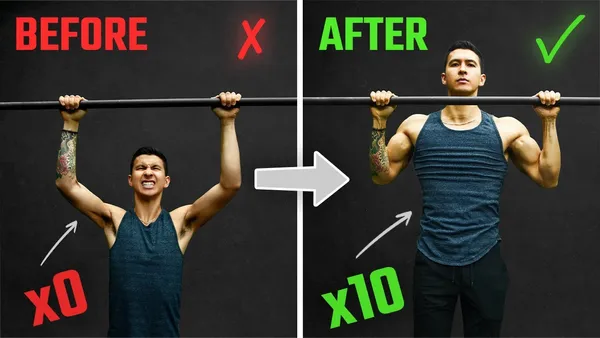
Mastering the Pull-Up Technique
To execute a proper pull-up, start by grasping the bar with an overhand grip, hands shoulder-width apart. Engage your core and lats, pull yourself up until your chin is above the bar, and lower yourself back down with control.
- For beginners, start with assisted pull-ups using a resistance band or a spotter.
- Focus on maintaining good form throughout the movement.
- Avoid kipping or swinging your body to generate momentum.
Building Strength and Muscles for Pull-Ups
To build the necessary strength and muscles for pull-ups, incorporate exercises that target the back, biceps, and forearms. Some effective exercises include:
Progressing from Negative Pull-Ups to Pull-Ups
Negative pull-ups are a great way to build the strength and control needed for regular pull-ups. Start by jumping up to the top position of a pull-up, then slowly lower yourself back down.
- Focus on controlling the descent rather than just dropping down.
- As you get stronger, gradually increase the number of negative pull-ups you can do before taking a break.
- Once you can do 8-10 negative pull-ups in a row, try transitioning to regular pull-ups.
Common Mistakes and Troubleshooting
If you're struggling to do pull-ups, consider these common mistakes and how to fix them:
Mistake | Solution |
|---|---|
Kipping or swinging | Focus on using your back and biceps, not momentum. |
Not engaging your core | Brace your core to stabilize your body. |
Pulling with your arms only | Use your back and lats to power the movement. |
Not breathing properly | Exhale as you pull yourself up and inhale as you lower down. |
Nutrition and Hydration
Proper nutrition and hydration are crucial for muscle growth and recovery. Make sure to consume a balanced diet with plenty of protein, carbohydrates, and healthy fats. Stay hydrated by drinking plenty of water throughout the day.
Stretching and Flexibility
Stretching and flexibility exercises can help improve your range of motion and reduce the risk of injuries. Incorporate regular stretching sessions into your routine, focusing on your back, shoulders, and arms.
Advanced Pull-Up Variations
Once you've mastered the basic pull-up, you can challenge yourself with advanced variations. These variations target different muscle groups and can help you build overall strength and athleticism.
Training Schedule and Frequency
To make progress in pull-ups, consistency is key. Aim to incorporate pull-ups into your workout routine at least 2-3 times per week. Start with a manageable number of repetitions and gradually increase the volume as you get stronger.
FAQs About Pull-Ups
Q: What are the benefits of doing pull-ups?
A: Pull-ups are a compound exercise that works multiple muscle groups in the back, biceps, and forearms. They can help improve upper body strength, muscle mass, and overall athleticism.
Q: How many pull-ups should I be able to do?
A: The number of pull-ups you can do depends on factors such as your age, weight, and fitness level. A good starting point for beginners is to aim for 5-10 pull-ups.
Q: Can I do pull-ups if I don't have a pull-up bar at home?
A: There are many ways to do pull-ups without a pull-up bar. You can use a sturdy tree branch, a playground structure, or even a doorframe with a sturdy towel.
IX. Variations and Progressions: Exploring Different Pull-Up Exercises
Variations and Progressions: Exploring Different Pull-Up Exercises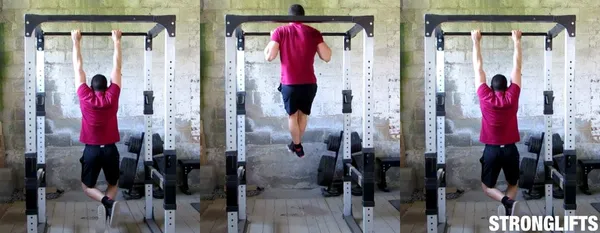
The pull-up is a classic exercise that targets the back, arms, and core. While the traditional pull-up is a challenging exercise, there are many variations and progressions that can be used to make it more accessible or to target different muscle groups. Here are a few examples:
- Assisted Pull-Ups: Assisted pull-ups are a great way for beginners to start building the strength needed for a traditional pull-up. These can be done with a resistance band or a pull-up machine that provides assistance.
- Negative Pull-Ups: Negative pull-ups involve slowly lowering yourself from a pull-up bar. This helps to build strength in the muscles used for the pull-up without having to lift your entire body weight.
- Chin-Ups: Chin-ups are a variation of the pull-up that targets the biceps more than the back. To do a chin-up, grip the bar with your palms facing towards you and pull yourself up until your chin is above the bar.
- Wide-Grip Pull-Ups: Wide-grip pull-ups target the lats more than the biceps. To do a wide-grip pull-up, grip the bar with your hands wider than shoulder-width apart and pull yourself up until your chest touches the bar.
- Close-Grip Pull-Ups: Close-grip pull-ups target the triceps more than the back. To do a close-grip pull-up, grip the bar with your hands closer together than shoulder-width apart and pull yourself up until your chest touches the bar.
Exercise | Target Muscles | Difficulty |
Assisted Pull-Ups | Back, arms, core | Beginner |
Negative Pull-Ups | Back, arms | Beginner |
Chin-Ups | Biceps, back | Intermediate |
Wide-Grip Pull-Ups | Lats, back | Intermediate |
Close-Grip Pull-Ups | Triceps, back | Advanced |
These are just a few examples of the many variations and progressions that can be used to perform pull-ups. By incorporating these exercises into your workout routine, you can target different muscle groups and challenge yourself to improve your strength and fitness.
In addition to the variations and progressions listed above, there are also a number of other factors that can affect the difficulty of a pull-up. These include the height of the bar, the width of your grip, and the speed at which you perform the exercise. By experimenting with these factors, you can find a pull-up variation that is challenging but still achievable for you.
If you are new to pull-ups, it is important to start slowly and gradually increase the difficulty of the exercise as you get stronger. It is also important to use proper form to avoid injury. If you are unsure about how to do a pull-up correctly, consult with a qualified personal trainer.
With a little practice, you can master the pull-up and enjoy the many benefits that this exercise has to offer. Pull-ups are a great way to build strength, improve your posture, and reduce your risk of back pain. So what are you waiting for? Start doing pull-ups today!
Here are some additional tips for doing pull-ups:
- Use a spotter: If you are new to pull-ups, it is a good idea to have a spotter help you. A spotter can help you to maintain proper form and prevent you from falling.
- Focus on your breathing: Breathe out as you pull yourself up and breathe in as you lower yourself down.
- Keep your core engaged: Your core muscles help to stabilize your body and prevent you from swinging. Keep your core engaged throughout the exercise.
- Don't overtrain: Pull-ups are a challenging exercise, so it is important to avoid overtraining. Start with a few sets of pull-ups and gradually increase the number of sets as you get stronger.
By following these tips, you can safely and effectively perform pull-ups and enjoy the many benefits that this exercise has to offer.
If you are looking for more information on pull-ups, check out these related posts:
X. Conclusion
Congratulations on taking the first step toward mastering the pull-up! Remember, progress takes time and consistency. As you embark on this journey, embrace the challenges and celebrate your achievements along the way. With dedication, proper form, and a well-rounded training regimen, you'll conquer the pull-up bar and unlock new levels of strength and fitness. Keep pushing your limits, and remember, the kizworld community is always here to support and motivate you on your fitness journey.